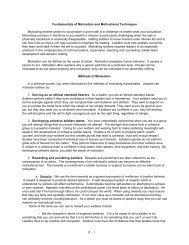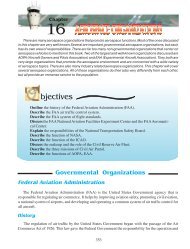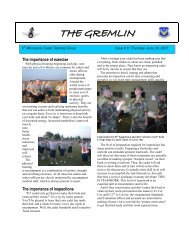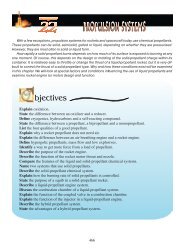Chapter 18 - The Atmosphere
Chapter 18 - The Atmosphere
Chapter 18 - The Atmosphere
You also want an ePaper? Increase the reach of your titles
YUMPU automatically turns print PDFs into web optimized ePapers that Google loves.
<strong>Chapter</strong><br />
<strong>18</strong><br />
<strong>The</strong> atmosphere is sometimes called “an ocean of air surrounding the earth.” You might also find it referred<br />
to as an “envelope of air,” or as a “gaseous covering.” Both are acceptable, but in this chapter the atmosphere<br />
will not be given a descriptive name. Instead, it will be examined for what it is: gaseous fluid that reacts to any<br />
force.<br />
bjectives<br />
Describe atmosphere and space as one medium termed aerospace.<br />
Identify the atmospheric elements.<br />
Recall the four ways of describing atmospheric regions.<br />
Define the various atmospheric regions.<br />
State the general characteristics of atmospheric pressure.<br />
Define the atmospheric regions.<br />
Describe the evaporation cycle.<br />
State the difference between condensation and precipitation.<br />
Identify the role of particulate matter in the water cycle.<br />
Define water vapor, dew point temperature, solar radiation, sublimation, humidity, relative<br />
humidity and condensation nuclei.<br />
Classify the four principal ways in which heat is transferred.<br />
Define insolation.<br />
Describe the importance of heat balance.<br />
Explain the Coriolis effect.<br />
Identify the types of pressure patterns used to depict pressure gradients on weather maps.<br />
Describe the effect of gravity, friction and centrifugal effect (force) on the wind.<br />
Explain the land and sea breeze phenomenon.<br />
Describe how turbulence can form around mountains.<br />
Describe the general characteristics of the jet stream.<br />
What is the <strong>Atmosphere</strong><br />
Before discussing the atmosphere, the two concepts “atmosphere” and “space” need to be clarified.<br />
Many people still believe the atmosphere and space are two separate regions. This is understandable<br />
knowing that an unprotected human being can live in the atmosphere, but not in space. We also know<br />
that the airplane can fly within the atmosphere, but cannot fly in space. For these reasons, it is natural<br />
for people to assume that space must be separate and different from the atmosphere.<br />
<strong>The</strong> problem is in searching for the dividing line between space and the atmosphere. Even scientists<br />
disagree as to where the atmosphere ends and space begins. <strong>The</strong>re are some people on earth who live,<br />
work and play high in the mountains where most of us would have difficulty breathing. <strong>The</strong>se people,<br />
386
<strong>Chapter</strong> <strong>18</strong> - <strong>The</strong> <strong>Atmosphere</strong><br />
over generations, have adapted to living<br />
in the very thin atmosphere. Who is<br />
to say that people could not adapt to<br />
living at even higher altitudes if given<br />
enough time to do so Airplanes can<br />
now fly much higher and in much thinner<br />
atmosphere than they once could. Thus,<br />
the dividing line between the atmosphere<br />
and space has, as far as people’s activities<br />
are concerned, been moved higher and<br />
higher over a period of time.<br />
No boundary line between atmosphere<br />
and space is found by looking at the<br />
composition of the atmosphere either.<br />
<strong>The</strong> only change is a gradual increase<br />
in the distance between the molecules<br />
and atoms that makeup the atmosphere.<br />
Considering these factors there is only<br />
one conclusion possible. <strong>The</strong> atmosphere<br />
and space are really one medium which<br />
<strong>The</strong> Earth’s <strong>Atmosphere</strong><br />
is best described by the compound term aerospace (aero. means atmosphere, plus the word space).<br />
For the purpose of this text, the word atmosphere will be used to describe the aerospace portion<br />
where humans do not require special life support systems and space will be used to define the area<br />
above the atmosphere where special equipment is needed.<br />
Later, chapters will show in more detail how the earth’s atmosphere is divided and named. Once<br />
beyond this measurable atmosphere, it is generally accepted that all else is space, and space extends<br />
in all directions for an infinite distance. <strong>The</strong> realm of “true” space has also been given names; these<br />
names—whether they pertain to the atmosphere, to space or to aerospace—are necessary as points of<br />
reference for the communication of thoughts and facts.<br />
Describing the <strong>Atmosphere</strong><br />
<strong>The</strong> atmosphere is a complex mixture of molecules and atoms. It is not easily or quickly described,<br />
but there are three major ways to study the makeup of the atmosphere: its elements, its regions, and<br />
its pressure.<br />
Atmospheric Elements<br />
<strong>The</strong> atmosphere is composed of 78 percent nitrogen and 21 percent oxygen. This leaves only one<br />
percent to be made up by other permanent and variable gases. <strong>The</strong> other permanent gases are argon,<br />
neon, helium, methane, hydrogen and xenon. <strong>The</strong> variable gases are water vapor, carbon dioxide,<br />
ozone, carbon monoxide, sulfur dioxide and nitrogen dioxide. Added to this pure mixture there are<br />
387
also dust particles, hydrocarbons and other matter given off by vehicles and industries, the pollens of<br />
plants, and so forth.<br />
Atmospheric Regions<br />
Certain levels of the atmosphere can be identified according to general characteristics, or atmospheric<br />
regions. <strong>The</strong> four usual ways of describing these regions (also called atmospheric shells or<br />
layers) are by temperature distribution, physicochemical (physical and chemical properties) processes<br />
distribution, molecular composition and dynamic-kinetic (force-motion) processes.<br />
Temperature Distribution. One of the most common and easiest ways to understand and describe<br />
the atmosphere is by temperature. <strong>The</strong>re are four distinct regions of the atmosphere where the temperature<br />
distribution is different enough to warrant a different name.<br />
<strong>The</strong> Troposphere and Tropopause. <strong>The</strong> troposphere is that region in which most people live,<br />
work, play and fly. It extends from the earth’s surface to about 10 miles above the earth at the equator<br />
(55,000 feet). In the polar regions, the troposphere is only slightly more than 5 miles in height (28,000<br />
feet). <strong>The</strong> reason for this is the change in the air temperature between the poles and the Equator. <strong>The</strong><br />
prefix “tropo” means to turn or change (sphere = layer), and this is just what the troposphere does.<br />
<strong>The</strong> atmosphere within this region is constantly turning and changing as it produces what is known as<br />
weather.<br />
In general, temperatures within the troposphere go down with increase in altitude at a fairly constant<br />
rate. <strong>The</strong>re are many factors that affect this rate, but it is generally accepted to be a 2° Celsius (C) or<br />
3.5° Fahrenheit (F) decrease with each 1,000 feet gained in altitude. This is known as the standard<br />
lapse rate (temperature).<br />
<strong>The</strong> tropopause is at the top of the troposphere (where the atmosphere becomes stable). <strong>The</strong> tropopause<br />
is the dividing line between the troposphere and the next higher layer (the stratosphere). <strong>The</strong><br />
tropopause is not a distinct dividing line. It undulates like the gentle swells of a calm sea as large areas<br />
of the atmosphere in the troposphere rise when heated and descend when cooled.<br />
Also, there are “steps” within the tropopause. <strong>The</strong>se steps are found where the jet streams occur.<br />
Jet streams are “tubes” of very high-speed air that encircle the Northern and Southern Hemispheres.<br />
<strong>The</strong>se jet streams are the upper-level dividing lines between the polar troposphere and the equatorial<br />
(or tropical) troposphere.<br />
<strong>The</strong> Stratosphere and Stratopause. <strong>The</strong> next region of the atmosphere is called the stratosphere.<br />
In this region, temperature goes up with increase in altitude. <strong>The</strong> stratosphere begins at 10 or so miles<br />
above the earth and extends upward to about 30 miles. From the base to the top of the stratosphere, the<br />
temperature goes up from about -60° C (-76° F) to about -40° C (-40° F). At 30 miles up, the warming<br />
trend stops and there is another dividing line called the stratopause.<br />
<strong>The</strong> Mesosphere and Mesopause. <strong>The</strong> next region is the mesosphere. From the stabilized -40°<br />
C stratopause, the mesosphere first shows a marked increase in temperature to 10° C (50° F), then<br />
a decrease until at about 50 miles altitude where the temperature has dropped to as low as -90° C<br />
(-130°F). This point is called the mesopause.<br />
<strong>The</strong>rmosphere. From 50 miles outward to about 300 miles, there is the region called the thermosphere.<br />
Here, the temperature increases again. How much it goes up depends on solar activity, but<br />
388
<strong>Chapter</strong> <strong>18</strong> - <strong>The</strong> <strong>Atmosphere</strong><br />
389
it is usually between 750° C (1,380° F) to 1,250° C (2,280° F). At this point, we are in space and<br />
temperature is a relative sort of thing. It depends on one’s closeness to the sun and whether or not the<br />
thermometer is in direct sunlight or is shaded from the sun.<br />
Physicochemical Processes Distribution. Atmospheric regions can also be described by the<br />
distribution of various physicochemical processes that happen in them. Included in this atmospheric<br />
classification are the ozonosphere, ionosphere, neutrosphere and chemosphere.<br />
Ozonosphere. <strong>The</strong> ozonosphere is a special region, or global shell, that extends from about 10<br />
to 30 miles altitude. In this region, the sun’s radiation reacts with the oxygen molecules and causes<br />
them to pickup a third atom creating ozone. <strong>The</strong> ozonosphere performs the very important function of<br />
shielding us from ultraviolet and infrared radiation that could be fatal.<br />
Ionosphere. <strong>The</strong> ionosphere begins at an altitude of about 25 miles and extends outward to about<br />
250 miles. Because of interactions between atmospheric particles and the sun’s radiation, there is a<br />
loss or gain in the electrons of the atoms and molecules, and thus the word “ion.” <strong>The</strong> floor of the<br />
ionosphere reflects certain radio waves. This allows them to be received at stations far away from the<br />
broadcasting station.<br />
Neutrosphere. <strong>The</strong> shell, or region, below the ionosphere that extends down to the surface of the<br />
earth is the neutrosphere. In this region, there is little ionization compared to that which takes place<br />
in the ionosphere.<br />
Chemosphere. <strong>The</strong> neutrosphere, ozonosphere and ionosphere extend upwards (vertically) without<br />
overlapping. <strong>The</strong> chemosphere is vaguely defined. It overlaps the ozonosphere and ionosphere and<br />
begins at about the stratopause, includes the mesosphere, and sometimes the lower part of the thermosphere.<br />
This is an important region because of a number of important photochemical (radiant energy<br />
and chemical) reactions occur within it.<br />
This is the ER-2<br />
airborne science<br />
aircraft. It is used<br />
to study earth<br />
resources, celestial<br />
observations,<br />
atmospheric<br />
chemistry and<br />
dynamics, global<br />
warming and<br />
ozone depletion.<br />
390
<strong>Chapter</strong> <strong>18</strong> - <strong>The</strong> <strong>Atmosphere</strong><br />
<strong>The</strong> DC-8 airborne<br />
laboratory conducts<br />
scientific studies<br />
in atmospheric<br />
chemistry,<br />
meteorology,<br />
oceanography and<br />
soil science.<br />
Molecular Composition. Describing the atmosphere by its molecular makeup results in two main<br />
regions: the homosphere and heterosphere.<br />
Homosphere. <strong>The</strong> homosphere extends from the earth’s surface up to an altitude of about 60 miles.<br />
<strong>The</strong> prefix “homo” means same; thus, the homosphere is that region in which the gaseous composition<br />
and mixing are relatively constant, i.e., 78 percent nitrogen and 21 percent oxygen.<br />
Heterosphere. <strong>The</strong> heterosphere (hetero is a prefix meaning different) begins around the 55- to<br />
60-mile altitude. In the heterosphere the molecules and atoms of the gases are spaced much farther<br />
apart. At this altitude, gravity influences them according to mass and they take on a vertical arrangement.<br />
<strong>The</strong> heaviest molecular nitrogen and oxygen are found in the lower part of the heterosphere.<br />
<strong>The</strong> lighter atomic oxygen, helium and hydrogen are in the upper part.<br />
Dynamic and Kinetic Processes. <strong>The</strong> exosphere is the top of the atmosphere above the heterosphere.<br />
<strong>The</strong> dynamic and kinetic processes that occur within the region determine the exosphere. In<br />
this region, the particles of the atmosphere move in free orbits subject only to earth’s gravity. <strong>The</strong><br />
bottom of the exosphere is estimated between 310 to 621 miles above the earth’s surface. <strong>The</strong> upper<br />
boundary of the exosphere extends into space without end.<br />
<strong>The</strong> exosphere begins in that region where the atmosphere’s molecules and atoms are so far apart<br />
they would have to travel as far as 100 miles before running into another molecule or atom. Within this<br />
region an atmospheric particle with enough velocity can escape from earth’s gravitational influence.<br />
This is why the lower part of the exosphere is also known as the “region of escape.”<br />
<strong>The</strong>re are several other regional classifications of the atmosphere that describe a particular condition<br />
or process that occurs. <strong>The</strong> thermal structure or temperature distribution is the most important.<br />
Within this structure, the troposphere will receive the most emphasis as it is where most of us spend<br />
our lives and it is where “weather” takes place. For a summary of the different classifications of the<br />
atmosphere, refer again to the chart on page 383.<br />
391
Atmospheric Pressure<br />
Earth’s gravitational force is what keeps atmospheric molecules from sailing off into space. This<br />
force becomes stronger the closer something is to the center of gravity. Earth’s center of gravity is considered<br />
to be near its core; therefore, gravitational influence is greatest at or below sea level on earth.<br />
Density indicates how tightly the particles of matter are packed together. This is also known as<br />
mass per unit volume. <strong>The</strong> density of air molecules decreases with increases in altitude. This happens<br />
for several reasons. Some molecules possess less mass than others. In addition, the molecules closer<br />
to the earth are under more gravitational influence than molecules higher up. <strong>The</strong> most significant fact<br />
is the weights of all air molecules press down upon all the other molecules below them. This is called<br />
pressure.<br />
Pressure is exerted in all directions within a given volume of air. At sea level, the pressure aver-<br />
Density: Mass Per Unit Volume<br />
ages about 14.7 pounds per square inch. <strong>The</strong> reason 14.7 pounds is an average is that the pressure at<br />
any one point fluctuates as cells of higher or lower pressure are formed and move across earth’s surface<br />
(this aspect of the atmosphere appears in a later section).<br />
Air pressure decreases with gains in altitude because of the lessening effect of gravity and the<br />
greater distance between the numbers of molecules present. For example, the pressure at <strong>18</strong>,000 feet<br />
(3.4 miles) is about one-half that at sea level. Going higher, to 35,000 feet (6.6 miles), we find the pressure<br />
less than one-fourth that of pressure at sea level. This rapid pressure decline continues the farther<br />
outward from earth’s surface we travel, until there is no measurable pressure. This is why pilots of<br />
very high-flying aircraft and astronauts must wear pressure suits. If they did not wear these suits, the<br />
Mass: Amount of Material<br />
392
<strong>Chapter</strong> <strong>18</strong> - <strong>The</strong> <strong>Atmosphere</strong><br />
“normal” pressure within their bodies would cause cells to rupture much like the way a balloon does<br />
when it rises into the upper atmosphere.<br />
Roles of Water and Particulate Matter<br />
Water in the <strong>Atmosphere</strong>. <strong>The</strong> water content of the atmosphere is almost restricted to the troposphere.<br />
<strong>The</strong>re are occasions when a particularly heavy thunderstorm will produce enough energy<br />
to thrust part of its top into the stratosphere. Water may also be injected into the stratosphere by the<br />
engines of high-flying aircraft. Still, water is usually only found in the troposphere.<br />
In the troposphere, however, water goes through a complete process cycle. From vapor, water goes<br />
to condensation then to precipitation.<br />
As it goes through this cycle, it takes on several forms. Water is seen in liquid forms as lakes, rain,<br />
dew and even as perspiration on our bodies. It can be in solid form as ice, hail or snow. It also appears<br />
as fog and clouds—the condensation stage of its cycle.<br />
Under normal conditions, water is not seen when it is part of the atmosphere—when it is a water<br />
vapor. If there is a relatively large amount of water vapor in the air, we say that it is humid, and when<br />
there is little water vapor, we say that the air is dry. However, no matter how dry the air may seem,<br />
there is always some water vapor present.<br />
<strong>The</strong> air is said to be “saturated” when it cannot hold any more water vapor. <strong>The</strong> amount of water<br />
vapor that can exist in the air increases with rising temperatures. <strong>The</strong> higher the temperature of the<br />
air, the more water vapor the air per unit volume can hold before saturation is reached. <strong>The</strong> lower the<br />
air temperature, the less water vapor a given volume of air can hold before it becomes saturated. <strong>The</strong><br />
term “dew point” is best defined as the air temperature at which saturation occurs. Thus, the amount<br />
of water vapor that can actually be in the air will depend on the temperature at any given time.<br />
In addition to temperature, pressure also affects how much water vapor a per unit volume of air<br />
can hold. Air is a gas and gases expand when the pressure on them decreases. As we gain altitude,<br />
pressure decreases and the air expands. This leaves more room for additional water vapor to enter a<br />
given volume of air and increases its saturation point.<br />
Thus, the water in the atmosphere that falls to earth, as well as the amount, will relate directly to<br />
the current temperature and pressure of the air. This concept is important in understanding the concept<br />
of relative humidity. <strong>The</strong> question at this point is how does water get into the air<br />
Evaporation. We know that temperature and pressure are the primary causes of water vapor in<br />
the air. What caused the vapor in the first place <strong>The</strong> air is constantly gaining and losing water, and<br />
the water vapor gets into the air by a process called evaporation. Evaporation is the process by which<br />
liquid water molecules change to a gas or vapor state and enter the earth’s atmosphere. <strong>The</strong> main factor<br />
in evaporation is temperature.<br />
A simple example of evaporation due to temperature is seen with boiling water. <strong>The</strong> high temperature<br />
causes the water molecules to escape from the liquid surface and rise into the air. <strong>The</strong> molecules<br />
immediately condense as steam because they saturate the air into which they are escaping. Soon, the<br />
steam disappears as it evaporates into the surrounding air, because its dew point temperature has been<br />
raised by the warm water vapor. If this vapor-laden air comes in contact with a surface cooler than<br />
393
Weight is in one direction, while pressure is in all directions—both decrease when altitude increases.<br />
it, the air temperature drops below its dew point and the vapor condenses into a liquid and the wall or<br />
ceiling becomes wet.<br />
Evaporation of water on a global scale takes place in a manner similar to the example above, but<br />
it is much more subtle. Most of the water vapor in the atmosphere comes from the oceans and other<br />
large bodies of water. A process called solar radiation heats the water causing the evaporation. <strong>The</strong><br />
warm moist air moves over cooler land and cools below its dew point causing the excess water vapor<br />
to fall back to the ground in some form of precipitation.<br />
Another method of putting water vapor into the atmosphere is called sublimation. This happens<br />
when water molecules leave the frozen (solid) state and directly enter the atmosphere without first changing<br />
into a liquid. This process requires more heat energy than the evaporation process. You may have<br />
witnessed the sublimation process during the wintertime when snow on the ground disappears without<br />
having melted. Sublimation also describes the formation of frost. That is, water vapor doesn’t condense<br />
first to a liquid before becoming frost; it goes directly from the vapor state to the frozen state.<br />
394
<strong>Chapter</strong> <strong>18</strong> - <strong>The</strong> <strong>Atmosphere</strong><br />
Evaporation Cycle<br />
Humidity and Relative Humidity. Invisible vapor is the water form usually associated with<br />
humidity. While there are many ways of explaining humidity, the simplest approach begins by emphasizing<br />
that<br />
1. temperature is the main cause of humidity and precipitation,<br />
2. before precipitation can occur, there must be enough water vapor present,<br />
3. the amount of water vapor the air is able to hold depends on the temperature of the air,<br />
4. warm air can hold more water vapor than cold air and<br />
5. as air cools, its ability to hold water vapor decreases.<br />
This chart shows relative humidity and temperature. When RH is 100% at a given temperature, the dew point is<br />
reached. It also shows that the ratio of A to B equals relative himidity and indicates how far away from saturation is<br />
the unit of air (C).<br />
395
Humidity is the term that indicates the amount of water vapor in the air. Absolute humidity tells you<br />
the actual percentage of water vapor in the air at a given time. Relative humidity is the method used<br />
to tell you the amount of water vapor that can still enter an air mass before it becomes saturated. It is<br />
expressed as a percentage, which is the ratio of the amount of water vapor in the air to the maximum<br />
amount that the same volume of air could contain at a given temperature and pressure.<br />
When the air is holding the maximum amount of water vapor for the existing temperature (i.e., 68°<br />
F) and pressure, the air is saturated (i.e., 17.31 grams) and the relative humidity is 100 percent. However,<br />
if the same unit of air were only holding a little more than half of the amount of water vapor it is<br />
capable of at that temperature, the relative humidity would be 54 percent (junction of 68° F and 9.41<br />
grams). This would leave 46 percent more water vapor that the given air mass could hold at 68° F.<br />
Looking at the figure on page 389 may make this relationship clearer. <strong>The</strong> ratio of A to B equals<br />
the relative humidity—a percentage indicator of how much more water (C) that the unit of air at 68° F<br />
could hold before reaching the saturation point (B), or 17.31 grams of water vapor. In this case, the unit<br />
of air could accept up to 7.9 grams more of vapor before it would be saturated. <strong>The</strong> relative humidity<br />
number is indicating how much more vapor the air is capable of holding at the time of measurement.<br />
This, in turn, gives a fair idea of when condensation and/or precipitation might occur—particularly<br />
important factors for pilots.<br />
Condensation and Precipitation. Periodically, part of the water vapor in the air returns to a liquid<br />
or solid form and is seen as condensation or precipitation. Clouds, fog, dew and frost are forms of<br />
condensation. Rain, sleet, snow and hail are forms of precipitation. If visible water falls, it is precipitation;<br />
if it does not, it is condensation.<br />
Condensation and precipitation occur due to lowered temperatures. Since cold air holds less moisture<br />
than warm air, simply lowering the temperature can increase the relative humidity. In doing so, the air<br />
holds less vapor and, if it is already saturated, the excess vapor condenses or turns into precipitation.<br />
If the temperature gets lower, and there is particulate matter in the air, the vapor can quickly change to<br />
a liquid state — a potential hazard to a pilot. If the air is cold enough, it can freeze and cause freezing<br />
rain — an even worse hazard for a pilot.<br />
Dew Point Temperature. <strong>The</strong> dew point temperature is the key factor in condensation and precipitation.<br />
<strong>The</strong> dew point temperature is the temperature at or below which water vapor will condense.<br />
This does not say that there will be clouds, rain, snow, fog, etc., as a result of condensation. On the<br />
contrary, it indicates that some type of condensation will take place if the air temperature drops to a<br />
certain level. When compared to the actual air temperature, it also reveals how close the air is to saturation<br />
and how close the air is to forming condensation and precipitation.<br />
Condensation and precipitation might be expected if the temperature dropped to 50° F (with no<br />
further vapor added to the air mass). This would be the dew point temperature. Relative humidity will<br />
have increased to 100 percent indicating that no more water vapor can be accepted into the air mass<br />
without condensation and precipitation probably occurring.<br />
<strong>The</strong> difference between the actual and the dew point temperature is called the “spread.” Relative<br />
humidity increases as the temperature spread decreases and is 100 percent when the spread is zero. At<br />
the dew point temperature, moisture in the air will condense to form clouds at higher altitudes and fog<br />
on the ground. Under the right conditions, precipitation could also occur. When the spread is within<br />
396
<strong>Chapter</strong> <strong>18</strong> - <strong>The</strong> <strong>Atmosphere</strong><br />
4 degrees and the difference is getting smaller, fog should be expected.<br />
Nothing about earth’s atmosphere and its weather is simple, because of the almost constant changes<br />
experienced at any single location. For example, a parcel of air could have its water vapor content<br />
changed quickly if another parcel of air came along and the two merged their individual characteristics.<br />
That is, a warm and moist parcel that could mix with a cold and dry parcel.<br />
If the mix were sudden, there would be some condensation because the temperature of the warm,<br />
moist air parcel would be lowered. At the same time, the cold, dry air parcel would be warmed. <strong>The</strong><br />
net result would be a new parcel of air with a capacity for holding an amount of water vapor that would<br />
be somewhere between that of the warm air and the cold air before the mixing took place. In everyday<br />
weather, this sort of thing takes place all the time.<br />
Particulate Matter<br />
Dust and other very small particles called particulate matter play an important role in weather. If<br />
they were not present in the atmosphere, there would not be certain forms of condensation and precipitation.<br />
<strong>The</strong>se particles serve as a surface for condensation of water vapor and are called condensation nuclei.<br />
<strong>The</strong> molecules of water attach themselves to these nuclei if the temperature is right. Water molecules<br />
continue to accumulate until they can be seen in their familiar liquid or solid forms. For an idea of just<br />
how small the condensation nuclei might be, the diameter of a single condensation nucleus could be<br />
as small as 0.000000004 inch (four billionths of an inch).<br />
<strong>Atmosphere</strong> in Motion<br />
<strong>The</strong> atmosphere is in constant motion in all directions: up, down and sideways. This is why the<br />
weather is constantly changing. If a unit of air is thought of as being the center of a sphere, its movement<br />
can be in any of the directions possible from the center of the sphere outward. This unit of air<br />
can be very small or it can involve hundreds of cubic feet.<br />
<strong>The</strong>re are two primary causes of atmospheric motion: heat and the motion of earth. Heat comes<br />
from the sun, and is critical in keeping the planet inhabitable. Thus, it is essential to examine how this<br />
thermonuclear heating system works.<br />
Heat and Temperature<br />
<strong>The</strong> heat energy contained within the atmosphere is responsible for all the earth’s weather processes.<br />
In review, remember the atmosphere is composed of molecules that are in constant motion. Because of<br />
this motion, the molecules possess energy. Heat is the sum total energy of all moving molecules within<br />
a substance. If something has a great deal of heat, the total energy of motion of all the molecules in the<br />
substance is high. Temperature, on the other hand, is a measure that expresses an average of the energy<br />
of molecular motion. Heat is a form of energy, and energy can be transformed and transferred.<br />
397
Methods of Heat Transfer<br />
<strong>The</strong>re are four principal ways in which heat is transferred from one place to another. <strong>The</strong>se are<br />
called conduction, convection, advection and radiation.<br />
Conduction. When one molecule (energized to a higher level of molecular motion through the<br />
heating process), contacts another molecule, the second molecule absorbs some of this heat. This is<br />
why the air above a layer of hot concrete, for example, becomes warmer than other surrounding air.<br />
Heating by direct contact is called conduction.<br />
Convection. Any heat transfer by vertical motion is called convection. An example is the rippling<br />
effect of air above a hot runway or highway in the summer. <strong>The</strong> air over these hot surfaces rises much<br />
more quickly than the air over surrounding surfaces. Thus, vertical currents are established in the atmosphere;<br />
some parcels of air are heated and rise, and other parcels of air are cooled and descend.<br />
Advection. When the wind blows, it is simply movement by or within the local air mass. Since<br />
that air mass has a certain temperature, that temperature will be transferred horizontally over the surface<br />
of the earth by blowing winds or moving air masses. This process of lateral heat transfer is called<br />
advection. Advection is an important factor in the global circulation of air.<br />
Radiation. <strong>The</strong> heat energy of the sun reaches earth as radiation. This method transfers heat energy<br />
without changing the temperature of anything between the source of energy and the object heated. Heat<br />
energy escapes a generating source in the form of waves. <strong>The</strong>se radiant waves (or rays) are themselves<br />
a form of energy and are part of the electromagnetic spectrum, which includes visible light. When<br />
radiant energy from one object reaches another object and is absorbed, the radiant energy is changed<br />
into some other form of energy, often heat.<br />
You can experience the effect of radiation, and its consequent heating effect, with an ordinary<br />
electric light bulb. Place your hand within one foot or so of a lighted bulb and hold it there for at least<br />
30 seconds. <strong>The</strong> radiant energy from the light bulb will warm your hand considerably. <strong>The</strong> same effect<br />
can be felt with a flashlight, but your hand will have to be much closer to the flashlight because it<br />
generates much less radiant energy than the light bulb. <strong>The</strong> radiant energy that comes from the light<br />
bulb or the flashlight and warms your hand is the same principle as sunlight warming the earth.<br />
Although radiant energy is never destroyed, it may be changed in many ways. Radiant waves may<br />
be absorbed or reflected by the clouds, scattered or reflected by dust in the air, or absorbed by the earth<br />
and converted into heat energy.<br />
As stated before, the evaporation process requires a lot of heat (radiant energy). Although the<br />
radiant energy is absorbed by the water, there is no increase in the temperature of the water vapor that<br />
results; no heat is lost.<br />
When the water vapor later condenses, heat is released and does affect the temperature of the surrounding<br />
air. This heat is known as the latent heat of condensation. This is a point to be remembered,<br />
since the heat released in this manner is a prime source of atmospheric energy. It is this latent heat<br />
energy that fuels such violent atmospheric disturbances as thunderstorms, tornadoes and hurricanes.<br />
398
<strong>Chapter</strong> <strong>18</strong> - <strong>The</strong> <strong>Atmosphere</strong><br />
Insolation<br />
<strong>The</strong> rate at which the earth’s surface is heated by solar radiation is called insolation. <strong>The</strong> amount<br />
of insolation received at any point on the earth’s surface depends on several factors: the angle the sun’s<br />
rays make with the horizon (called the angle of incidence), the distance of the earth from the sun and<br />
the amount of radiation absorbed by the atmosphere. On clear days more radiation reaches the earth’s<br />
surface than on cloudy days. Very dense cloud formations may reflect as much as three-fourths of the<br />
radiant energy from the sun.<br />
Insolation is greatest in the equatorial zone. <strong>The</strong> sun’s rays are nearly perpendicular to the earth’s<br />
surface. <strong>The</strong>refore, more radiant waves per equal area (hence, more heat) reach the equatorial zone<br />
than reach the temperate zones, and more reach the temperate zones than reach the polar zones.<br />
<strong>The</strong> Heat Balance<br />
Insolation varies with latitude.<br />
If there were no balance of heat between the earth, its atmosphere and space, the earth would become<br />
increasingly warmer. This does not happen because the insolation is in turn radiated back from the<br />
earth into space or the atmosphere.<br />
399
It is estimated that of all<br />
the solar radiation arriving at<br />
the top of the atmosphere, 30<br />
percent is reflected into space<br />
by clouds and atmospheric dust,<br />
20 percent is absorbed directly<br />
into the atmosphere, and 50<br />
percent reaches the earth. Of<br />
the 20 percent absorbed directly<br />
into the atmosphere, 4 percent<br />
eventually reaches the earth as<br />
diffused sky radiation. Thus,<br />
about 55 percent of all the<br />
incident solar radiation reaches<br />
the earth and heats it.<br />
<strong>The</strong> heated earth’s surface,<br />
in turn, radiates infrared rays<br />
upward. Part of these rays<br />
(about 39 percent) are absorbed<br />
by the atmosphere are converted<br />
into heat. This process provides the principal source of heat for the troposphere. <strong>The</strong> rest of the<br />
Solar Radiation<br />
infrared rays (about 8 percent) escape into space with no heating effect. <strong>The</strong> radiative processes that<br />
tend to maintain the earth’s heat balance are also chiefly responsible for worldwide weather.<br />
Wind<br />
Heated air rises. It rises because the heat applied to it has decreased its density to the point where it<br />
is lighter in weight than the surrounding air, and the surrounding, cooler air pushes the parcel of lighter<br />
air upward. This same effect can be seen in the flight of a hot-air balloon.<br />
When this heated air rises, cooler, higher-pressure air flows sideways to fill the lower-pressure area<br />
created. This lateral movement is referred to as wind. Basically, the same type of exchange takes place<br />
on a global level, but in much larger proportions. All along the equatorial zone the air is heated more<br />
than at any other area. In the polar regions, where the angle of incidence is least, the least amount of<br />
heating takes place. <strong>The</strong> general trend is, therefore, for the cold air from the polar region to flow toward<br />
the equatorial zone. This occurs while the heated air of the equatorial zone is rising and drifting<br />
toward the poles.<br />
<strong>The</strong> rotation of the earth complicates this simple concept of wind. <strong>The</strong> rotation causes the alternating<br />
heating and cooling of the equatorial and other regions during day and night. Perhaps the most<br />
significant influence on the creation and flow of wind is the spinning planet and the resulting Coriolis<br />
Effect.<br />
400
<strong>Chapter</strong> <strong>18</strong> - <strong>The</strong> <strong>Atmosphere</strong><br />
Global Winds<br />
Coriolis Effect<br />
<strong>The</strong> atmosphere is a part of the earth held by the earth’s gravity. However, the atmosphere is not<br />
rigidly attached to the earth. <strong>The</strong> atmosphere may move with relationship to the earth, and the earth<br />
may move with relationship to the atmosphere.<br />
<strong>The</strong> earth rotates on its axis in such a way that an observer in space over the North Pole would<br />
see the earth turning in a counterclockwise direction. <strong>The</strong> rotation of the earth influences any object<br />
moving over its surface. This influence is called the Coriolis Effect after the French physicist who first<br />
explained it in <strong>18</strong>35.<br />
<strong>The</strong> Coriolis Effect can be illustrated by imagining the earth as the turntable on a record player<br />
with the center of the turntable representing the North Pole and the rim being the Equator.<br />
1. Place paper on top of the turntable and cut it to the same circular dimension.<br />
2. Start the turntable rotating in a counterclockwise direction.<br />
3. Using a ruler and pencil, quickly draw a straight line from the center (North Pole) to the rim<br />
(Equator) of the rotating turntable.<br />
To the person drawing the line, the pencil line traveled in a straight line. When the turntable is<br />
stopped, it can be seen. <strong>The</strong> line is not straight but is curved to the right or west. Similarly, a line<br />
drawn from the rim (Equator) to the center (North Pole) of the turntable, the line would curve to the<br />
left or east.<br />
Anytime the atmosphere is in motion, the Coriolis Effect caused by the rotation of the earth influences<br />
it. <strong>The</strong> heated air rises over the Equator and begins to travel toward the poles. However, the Coriolis<br />
effect acting on this mass of moving air will deflect it to the east in the Northern Hemisphere. By the<br />
401
<strong>The</strong> air flowing from 30° N latitude toward the Equator is deflected toward the west. This creates<br />
the trade winds that blow toward the southwest in the Northern Hemisphere. <strong>The</strong> air flowing from 30°<br />
latitude toward the North Pole is deflected toward the east. This creates the prevailing westerlies that<br />
blow toward the northeast between 30° N latitude and 60° N latitude. <strong>The</strong> same conditions occur in<br />
the Southern Hemisphere, but the directions of flow are reversed because the direction of rotation in<br />
the Southern Hemisphere is clockwise.<br />
At the same time, some of the air aloft continues to flow toward the poles, cools, settles to the<br />
surface, and begins a return trip toward the Equator. <strong>The</strong> warmer surface air moving up from latitude<br />
30° overruns this colder air and produces a high-pressure condition in the polar zones. When the polar<br />
high pressure becomes sufficient, massive cold-air surges break out of the polar zones. <strong>The</strong>se surges<br />
of air move toward the Equator and cause the changing weather conditions of the middle latitudes.<br />
<strong>The</strong> Pressure Gradient<br />
Example of the Coriolis Effect<br />
time this air mass reaches<br />
30° N latitude, it is no longer<br />
traveling north. It has been<br />
deflected and is moving<br />
straight east. As the mass of<br />
air cools, it becomes denser<br />
and sinks toward the earth,<br />
creating a high-pressure belt<br />
at this latitude.<br />
As the air pressure builds<br />
up within this belt, some of it<br />
is forced downward toward<br />
earth’s surface. A portion<br />
flows toward the Equator<br />
along the surface; another<br />
portion flows toward the pole<br />
along the surface. As these<br />
surface winds move toward<br />
the poles and the Equator,<br />
the Coriolis Effect again<br />
comes into play, deflecting<br />
the moving air masses.<br />
Several factors cause the atmosphere to be a constantly changing landscape of invisible mountains<br />
and valleys. <strong>The</strong> major influences are the uneven distribution of oceans and continents, the seasonal<br />
temperature changes, the heat transferring qualities of different earth surfaces and daily temperature<br />
changes. <strong>The</strong> high-pressure areas of the atmosphere are the mountains and the low-pressure areas are<br />
the valleys. <strong>The</strong> wind flows from these high-pressure mountains into the low-pressure valleys.<br />
402
<strong>Chapter</strong> <strong>18</strong> - <strong>The</strong> <strong>Atmosphere</strong><br />
<strong>The</strong> Pressure Gradient<br />
<strong>The</strong> slope of the high-pressure mountain<br />
is called the pressure gradient. On weather<br />
maps, its degree of steepness is shown by<br />
lines called isobars. Isobars are drawn<br />
through points of equal sea-level atmospheric<br />
(barometric) pressure. <strong>The</strong>y identify five<br />
different types of pressure patterns—highs,<br />
lows, cols, troughs, and ridges. A high is a<br />
center of high pressure surrounded by lower<br />
pressure, and a low is a center of low pressure<br />
surrounded by higher pressure. A col is<br />
a “saddle-back” area between two highs and<br />
two lows. An elongated area of low pressure<br />
is called a trough. An elongated area of high<br />
pressure is called a ridge.<br />
Other Factors Affecting the Wind<br />
Other factors that affect the circulation of the air (wind) are gravity, friction and centrifugal effect<br />
(also known as centrifugal force). Gravity tends to pull the air downward and produce a graduated<br />
air-density distribution, with the greatest air density near the earth’s surface. Friction tends to slow air<br />
movement from the earth’s surface up to 6,000 feet or more.<br />
Centrifugal force acts on air moving in a curved path, and decreases its speed within a low-pressure<br />
area and increases it within a high-pressure area. In the Northern Hemisphere, the air flows clockwise<br />
around the high-pressure area (an anticyclone) and counterclockwise around a low-pressure area (a<br />
cyclone). In the Southern Hemisphere the directions are reversed.<br />
It should be noted that at an altitude where surface friction ceases to affect wind movement, the<br />
wind always blows parallel to the isobars. At this level (called the wind level), pressure gradient,<br />
centrifugal effect, and the Coriolis Effect are in balance. <strong>The</strong> wind at this level is called the gradient<br />
wind. Its speed is always inversely proportional to the distance between the isobars. This means that<br />
when the isobars on a weather map are far apart, the wind is weak; when they are close together, the<br />
wind is strong. Aviators always try to take advantage of favorable winds, and plan and navigate their<br />
flights accordingly.<br />
Local and Surface Air Movements<br />
<strong>The</strong> general circulation of the air is complicated by the irregular distribution of land and water areas.<br />
Different types of surfaces vary in the rate at which they absorb heat from the sun and transfer heat to<br />
the atmosphere. Seasonal changes and daily variations in temperature also affect this rate of transfer.<br />
In some regions, local low-pressure areas form over hot land surfaces in summer, and over the warmer<br />
water surfaces in winter. Convection currents are formed along shorelines. <strong>The</strong>se currents are<br />
403
heated air rising upward, which cause advection currents (wind) to flow from the water over the warmer<br />
land during the day. During the night, convection currents develop over the warmer-than-land water<br />
and cause the wind to blow from the land toward the water. This phenomenon is known as the land<br />
and sea breeze.<br />
Local air circulation of limited scope is caused by variations in the earth’s surface. Some surfaces—<br />
such as sand, rocks, plowed areas and barren land—give off or reflect a great amount of heat.<br />
Other surfaces—such as meadows, planted fields and water—tend to retain heat. Rising air currents<br />
are encountered by aircraft flying over surfaces that give off considerable heat, while descending air<br />
currents are encountered over surfaces that tend to retain heat.<br />
Moving air flowing around obstructions tends to break into eddies. On the leeward (opposite of<br />
the windward) side of mountains, there are descending air currents. Such conditions cause turbulent<br />
air. <strong>The</strong> stronger the wind, the greater the descending air currents and turbulence. Aviators flying<br />
into the wind toward mountainous terrain should place enough distance between their aircraft and the<br />
mountaintops to avoid dangerous descending air currents.<br />
Land and Sea Breeze Phenomenon<br />
<strong>The</strong>rmals, advection currents, convection currents, wind, updrafts and downdrafts affect air movement.<br />
404
<strong>Chapter</strong> <strong>18</strong> - <strong>The</strong> <strong>Atmosphere</strong><br />
<strong>The</strong> Jet Stream<br />
<strong>The</strong> jet stream, as mentioned earlier, is a comparatively<br />
narrow current of air that moves around<br />
the Northern (and Southern) Hemispheres of the<br />
earth in wavelike patterns. It might be compared<br />
to a “river” of wind moving at high speed. <strong>The</strong> jet<br />
stream varies from about 100 to 400 miles wide and<br />
1 to 3 miles thick. Its strongest winds are generally<br />
encountered above 30,000 feet. Jet-stream winds<br />
usually have a speed of 150 to 300 mph, but speeds<br />
up to 450 mph have been recorded. Its general<br />
motion is from west to east.<br />
<strong>The</strong> jet stream shifts position frequently and<br />
actually migrates with the seasons. Sometimes<br />
two streams flow across the United States, one<br />
along the northern border and the other well toward<br />
the south. <strong>The</strong> cruising range of aircraft flying<br />
downwind within a jet stream is greatly increased.<br />
Pilots anticipating high-altitude or long-range<br />
flights attempt to discover the location of the jet<br />
stream and use it to their advantage.<br />
Descending Air Currents on Leeward Side of a Mountain<br />
405
For several decades now, meteorologists have studied jet streams and how they affect the movements<br />
of air masses. While the relationship is still unknown, there is a common agreement that jet streams<br />
may act as a barrier between cold air in the north and warm air in the south. During their snakelike<br />
meandering, the streams appear to allow some cold air to flow southward and warm air to flow northward.<br />
<strong>The</strong>se flows undoubtedly have some affect on the formation of cold and warm air masses.<br />
• atmosphere<br />
• aerospace<br />
• atmospheric elements<br />
• four ways to classify atmospheric regions<br />
• temperature distribution: troposphere, stratosphere, mesosphere, thermosphere<br />
• physicochemical process distribution: ozonosphere, ionosphere, neutrosphere, chemosphere<br />
• molecular composition: heterosphere and homosphere<br />
• dynamic and kinetic processes: exosphere<br />
• density, pressure and mass<br />
• condensation<br />
• humidity and relative humidity<br />
• saturation<br />
• dew point<br />
• evaporation<br />
• solar radiation<br />
• sublimation<br />
• condensation and precipitation<br />
• fog<br />
• particulate matter<br />
• condensation nuclei<br />
• heat and temperature<br />
• conduction<br />
• convection<br />
• advection<br />
• radiation<br />
• insolation<br />
• Coriolis Effect<br />
• pressure gradient<br />
• isobars<br />
• centrifugal force<br />
• land-sea breeze phenomena<br />
• jet stream<br />
406
<strong>Chapter</strong> <strong>18</strong> - <strong>The</strong> <strong>Atmosphere</strong><br />
SELECT THE CORRECT ANSWER<br />
1. <strong>The</strong> atmosphere and space are really one medium best described by the term (aeronautical /<br />
aerospace / aeroplane).<br />
FILL IN THE BLANKS<br />
2. Temperature is a measure of _________. A _________ is used to measure the amount of heat or<br />
the lack of it.<br />
3. If visible water falls, it is _________; if it does not, it is _________.<br />
4. Particulate matter can be in the form of dust, dirt, smoke, exhaust fumes or even salt particles. If<br />
the temperature is right, these particles can serve as _________ for _________.<br />
5. <strong>The</strong> following terms are part of the _________ cycle:<br />
dew point temperature<br />
solar radiation<br />
sublimation<br />
saturate<br />
6. <strong>The</strong> difference between the actual and the dew point temperature is called the _________.<br />
7. <strong>The</strong> rate at which the _________ surface is heated by _________ radiation is called insulation.<br />
8. <strong>The</strong> radiation processes that tend to maintain the earth’s _________ _________ are also chiefly<br />
responsible for worldwide weather.<br />
9. Wind is generally referred to as a _________ movement of air.<br />
10. <strong>The</strong> rotation of the earth affecting anything moving over its surface is one way of defining the<br />
_________.<br />
MATCHING<br />
11. Heating by direct contact a. Radiation<br />
12. Process of lateral heat transfer b. Advection<br />
13. Heat transfers by vertical motion c. Convection<br />
14. Heat energy of the sun-reaching earth d. Conduction<br />
407
MULTIPLE CHOICE<br />
15. Centrifugal effect acts on air moving in a curved path and decreases its speed within a lowpressure<br />
area and<br />
a. decreases it within a high-pressure area.<br />
b. increases it within a high-pressure area.<br />
c. stops it within a high-pressure area.<br />
d. none of the above.<br />
16. Friction tends to<br />
a. have no affect on air movement.<br />
b. increase air movement.<br />
c. slow air movement.<br />
d. all of the above.<br />
17. Gravity tends to pull air downward with the greatest air density<br />
a. near the earth’s surface.<br />
b. next to the jet stream.<br />
c. at the tropopause.<br />
d. near the sun.<br />
<strong>18</strong>. Unequal heating by the sun’s rays of land and water areas causes<br />
a. the land and sea-breeze phenomena.<br />
b. the thermal downdraft.<br />
c. winds to stay aloft.<br />
d. none of the above.<br />
19. Different types of earth’s surfaces vary in the rate at which they<br />
a. reflect the sun’s heat and transfer the sun’s heat to the atmosphere.<br />
b. absorb the sun’s heat and transfer the sun’s heat to the atmosphere.<br />
c. absorb the sun’s heat and transform heat to the atmosphere.<br />
d. avoid the sun’s heat and reflect heat to the atmosphere.<br />
20. Jet streams shift positions frequently and<br />
a. have some effect on the formation of cold and warm air masses.<br />
b. can be compared to a river of air.<br />
c. actually migrate with the seasons.<br />
d. all of the above.<br />
TRUE OR FALSE<br />
21. Density is the comparison of how heavy something is to the space it fills.<br />
22. Liquid water will evaporate only if there is space in the air for the water vapor molecules to<br />
occupy.<br />
23. A high is a center of high pressure surrounded by higher pressure.<br />
24. An elongated area of high pressure is called a ridge.<br />
408
<strong>Chapter</strong> <strong>18</strong> - <strong>The</strong> <strong>Atmosphere</strong><br />
25. A low is a center of low pressure surrounded by even lower pressure.<br />
26. An elongated area of low pressure is called a trough.<br />
27. A col is a “saddleback” area between a high and a low.<br />
SHORT ANSWER<br />
28. Explain the difference between humidity and relative humidity.<br />
29. Cite examples of how heat energy can be transformed and transferred.<br />
30. Review the term standard lapse rate and solve the following problem: You are at the ocean<br />
beach on a hot summer day and the thermometer registers 92° F. What would be the<br />
temperature reading for the pilot directly above you flying at 8,000 feet<br />
31. <strong>The</strong> following examples involve atmospheric pressure. Give a brief explanation of each.<br />
a. <strong>The</strong> doors on a new car will not close unless a window is partially open.<br />
b. Your ears “pop” if you go up or down a mountain.<br />
c. You usually make two holes in the top of a metal can in order to remove the liquid.<br />
409
















